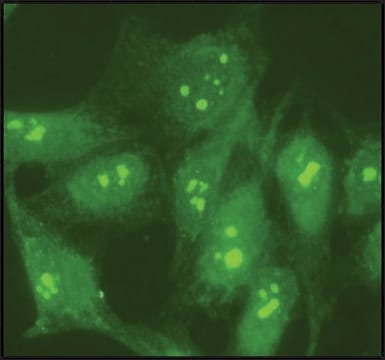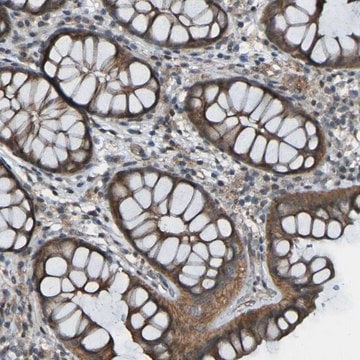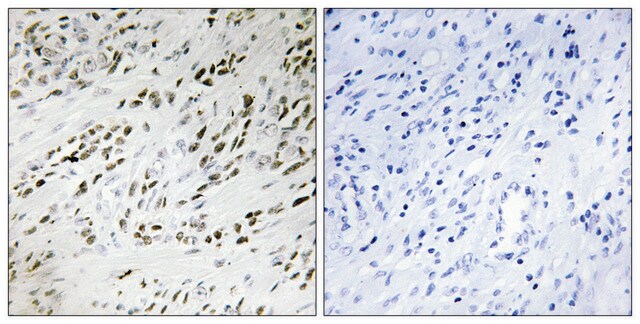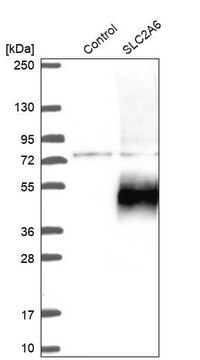Recommended Products
biological source
mouse
Quality Level
conjugate
unconjugated
antibody form
purified antibody
antibody product type
primary antibodies, primary antibodies
clone
125-10, monoclonal
purified by
using protein G
species reactivity
human
packaging
antibody small pack of 100 μg
technique(s)
immunocytochemistry: suitable
immunofluorescence: suitable
isotype
IgG1κ
epitope sequence
Unknown
shipped in
dry ice
target post-translational modification
unmodified
General description
The nucleoli small basophilic, spherical, non-membrane enclosed, highly conserved, structures that are localized within the nucleus. Usually, they are localized in the central nuclear region or close to the nuclear membrane. They are formed around nucleolus organizer regions (NORs) consisting of ribosomal DNA (rDNA). They are structurally organized into the fibrillar center, the dense fibrillar component, and the granular component region. Clone 125-10 detects human nucleoli by immunocytochemistry.
Specificity
Clone 125-10 is a mouse monoclonal antibody that specifically detects nucleoli in human cells.
Immunogen
Raji cell nuclei.
Application
Quality Control Testing
Evaluated by Immunocytochemistry in A431 cells.
Immunocytochemistry Analysis: A 1:1,000 dilution of this antibody detected Nucleoli in A431 cells.
Tested Applications
Immunocytochemistry Analysis: A representative lot detected Nucleoli in Immunocytochemistry applications (Endo, A., et al. (2009). J Biol Chem. 284(41):27918-27923; Endo, A., et al. (2009). J Cell Sci. 122(Pt 5):678-86).
Immunofluorescence Analysis: A representative lot detected Nucleoli in Immunofluorescence applications (Clements, D., et al. (2007). Am J Physiol Lung Cell Mol Physiol. 292(1):L258-66; Vallee, D., et al. (2004). J Med Genet. 41(10):778-83; Ohno, M., et al. (2002). Chromosoma. 111(3):201-13).
Note: Actual optimal working dilutions must be determined by end user as specimens, and experimental conditions may vary with the end user
Evaluated by Immunocytochemistry in A431 cells.
Immunocytochemistry Analysis: A 1:1,000 dilution of this antibody detected Nucleoli in A431 cells.
Tested Applications
Immunocytochemistry Analysis: A representative lot detected Nucleoli in Immunocytochemistry applications (Endo, A., et al. (2009). J Biol Chem. 284(41):27918-27923; Endo, A., et al. (2009). J Cell Sci. 122(Pt 5):678-86).
Immunofluorescence Analysis: A representative lot detected Nucleoli in Immunofluorescence applications (Clements, D., et al. (2007). Am J Physiol Lung Cell Mol Physiol. 292(1):L258-66; Vallee, D., et al. (2004). J Med Genet. 41(10):778-83; Ohno, M., et al. (2002). Chromosoma. 111(3):201-13).
Note: Actual optimal working dilutions must be determined by end user as specimens, and experimental conditions may vary with the end user
Anti-Nucleoli, clone 125-10, Cat. No. MAB1277-I, is a mouse monoclonal antibody that detects nucleoli and is tested for use in Immunocytochemistry, Immunofluorescence, and Immunocytochemistry.
Physical form
Purified mouse monoclonal antibody IgG1 in PBS without preservatives.
Storage and Stability
Store at -10°C to -25°C. Handling Recommendations: Upon receipt and prior to removing the cap, centrifuge the vial and gently mix the solution. Aliquot into microcentrifuge tubes and store at -20°C. Avoid repeated freeze/thaw cycles, which may damage IgG and affect product performance.
Other Notes
Concentration: Please refer to the Certificate of Analysis for the lot-specific concentration.
Disclaimer
Unless otherwise stated in our catalog or other company documentation accompanying the product(s), our products are intended for research use only and are not to be used for any other purpose, which includes but is not limited to, unauthorized commercial uses, in vitro diagnostic uses, ex vivo or in vivo therapeutic uses or any type of consumption or application to humans or animals.
Storage Class Code
12 - Non Combustible Liquids
WGK
WGK 2
Flash Point(F)
Not applicable
Flash Point(C)
Not applicable
Certificates of Analysis (COA)
Search for Certificates of Analysis (COA) by entering the products Lot/Batch Number. Lot and Batch Numbers can be found on a product’s label following the words ‘Lot’ or ‘Batch’.
Already Own This Product?
Find documentation for the products that you have recently purchased in the Document Library.
Our team of scientists has experience in all areas of research including Life Science, Material Science, Chemical Synthesis, Chromatography, Analytical and many others.
Contact Technical Service







